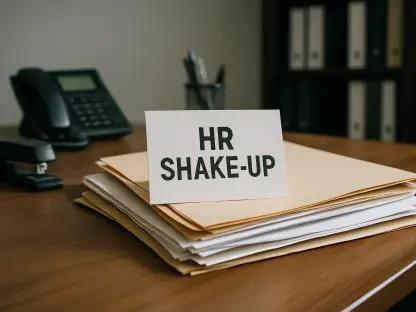Imagine walking into a workplace every day, knowing that your years of experience might be met not with respect, but with subtle disdain or outright bias, a harsh reality for a staggering 90% of workers over 50 as revealed by recent surveys on age discrimination. This roundup dives into the pervasive issue of ageism in professional settings, gathering opinions, tips, and strategies from various industry perspectives, advocacy groups, and legal experts. The purpose is to shed light on the multifaceted nature of workplace bias against older employees and to explore actionable ways to combat it, fostering environments where talent transcends age.
Diverse Perspectives on the Prevalence of Ageism
Insights from multiple surveys and studies paint a grim picture of age discrimination in today’s workplaces. A comprehensive poll of nearly 900 older workers found that 90% have encountered some form of bias, ranging from dismissive attitudes to outright exclusion. Advocacy groups emphasize that this statistic highlights a systemic problem, often overshadowed by other forms of discrimination, yet equally damaging to career progression and mental well-being.
Contrasting views emerge on why ageism persists so stubbornly. Some industry observers argue that cultural norms play a significant role, with societal tendencies to equate youth with innovation often sidelining seasoned professionals. Others point to economic factors, suggesting that employers may view older workers as costlier due to higher salaries or perceived resistance to change, though this overlooks the value of their expertise.
A third angle comes from workplace psychologists who note the emotional toll of such bias. Reports indicate that 83% of older employees feel disrespected at times, while a smaller but significant portion experience patronizing behavior from younger peers. These daily slights, though often subtle, chip away at confidence and create a hostile environment, prompting calls for deeper cultural shifts within organizations.
Unpacking the Forms of Workplace Age Bias
Emotional Impact: Disrespect and Stereotypes
Delving into personal experiences, many older workers describe a constant undercurrent of disrespect as a primary manifestation of ageism. Advocacy organizations report that dismissive comments or assumptions about technological incompetence are commonplace, eroding morale over time. Such behaviors are often unintentional but reflect ingrained stereotypes about aging.
Another perspective focuses on the role of intergenerational dynamics. Some HR professionals suggest that younger employees may lack awareness of how their actions or words can alienate older colleagues, pointing to a need for education on workplace respect. This view contrasts with opinions that hold management accountable for setting the tone, arguing that leadership must model inclusive behavior to effect change.
A different lens examines societal tolerance for age-related bias. Commentators note that unlike other forms of discrimination, ageism is sometimes seen as less serious or even humorous in popular culture. This normalization makes it harder to address, as affected workers may hesitate to speak out, fearing they won’t be taken seriously or will be labeled as overly sensitive.
Career Setbacks: Pay Gaps and Stalled Opportunities
Turning to tangible impacts, numerous reports highlight disparities in compensation and advancement as key issues. Over half of surveyed older workers earn less than younger counterparts for similar roles, while others face barriers to promotions or are nudged toward early retirement. Industry analysts warn that such practices not only harm individuals but also deprive companies of valuable institutional knowledge.
Legal perspectives add depth to this discussion, with some experts citing high-profile cases where corporate decisions explicitly targeted older employees for layoffs or demotions. These actions often stem from cost-cutting motives, but they raise ethical questions about fairness and the long-term cost to organizational culture. Differing opinions exist on whether stricter penalties for such behavior would deter companies or simply drive bias underground.
A counterpoint comes from business consultants who argue that employers are beginning to recognize the risks of undervaluing older talent, especially in industries facing skill shortages. They advocate for mentorship programs where seasoned workers can share expertise, turning potential liabilities into assets. This approach, however, requires a shift in mindset that not all organizations are ready to embrace.
Technology’s Role: AI and Emerging Challenges
The rise of technology, particularly AI in HR processes, introduces a new frontier for age discrimination, according to tech watchdogs. Lawsuits against software providers allege that automated systems may unintentionally favor younger candidates by prioritizing certain keywords or career patterns more common among early-career professionals. This concern is gaining traction as courts demand transparency from tech companies.
On the other hand, some tech industry voices defend the use of AI, asserting that algorithms can be designed to minimize bias if properly audited. They argue that the problem lies not with technology itself but with how it’s implemented, urging companies to involve diverse teams in developing these tools. This optimistic view contrasts with more cautious opinions that question whether such oversight is feasible on a wide scale.
A third perspective focuses on regional differences in AI adoption for hiring and promotions. In areas with heavier reliance on automated systems, older workers may face greater risks of exclusion, while other regions lag in tech integration, potentially sparing them from these biases for now. This disparity underscores the uneven landscape of workplace fairness and the need for standardized guidelines to govern tech use.
Legal Safeguards: Strengths and Shortcomings
Legal frameworks like the Age Discrimination in Employment Act provide critical protections for workers over 40, as noted by policy analysts. However, many agree that legislation alone cannot eradicate deep-seated bias, especially when enforcement remains inconsistent. Cases involving seemingly harmless inquiries about retirement plans escalating into lawsuits illustrate the complexity of proving intent.
Some legal scholars argue that ageism often flies under the radar compared to other forms of discrimination due to weaker public outcry or judicial focus. They suggest reforms like mandatory reporting of age-related complaints to increase visibility, though others caution that such measures could burden small businesses without addressing root causes. This debate highlights the tension between policy and practicality.
Advocacy groups offer a complementary view, stressing that cultural change must accompany legal efforts. They point to the importance of educating employers about subtle forms of bias, such as assumptions about an older worker’s career goals. Without this dual approach, laws risk becoming symbolic rather than transformative, leaving many workers vulnerable to ongoing discrimination.
Strategies and Tips to Combat Age Discrimination
Drawing from a range of sources, several actionable strategies emerge to tackle ageism in the workplace. Advocacy organizations recommend integrating age into diversity, equity, and inclusion training to raise awareness of unconscious biases. This step is seen as essential for fostering empathy and dismantling stereotypes that fuel disrespectful behavior.
HR consultants offer practical advice for employers, urging regular audits of AI-driven tools to ensure they don’t inadvertently disadvantage older candidates. They also suggest creating clear policies on equal pay and promotions, backed by transparent metrics to hold leadership accountable. Such measures aim to address systemic inequities at their source.
For employees and allies, community leaders encourage speaking out against ageist remarks or practices, even in small ways. Supporting policies that protect older workers, whether through internal advocacy or broader legislative efforts, is another key tip. These collective actions, paired with education, form a multi-pronged approach to building fairer workplaces for all generations.
Reflecting on the Path Forward
Looking back on this roundup, the discussions revealed a pervasive challenge of age discrimination that touches 90% of older workers, manifesting through disrespect, career barriers, and technological biases. Varied perspectives from advocacy groups, legal experts, and industry voices underscored the complexity of the issue, with no single solution emerging as a cure-all. The emotional and professional toll on affected individuals stood out as a unifying concern across all viewpoints.
Moving forward, organizations must prioritize inclusive training and rigorous oversight of automated systems to prevent bias from taking new forms. Employees, too, play a crucial role by challenging stereotypes in their daily interactions. Exploring resources on workplace equity and engaging with advocacy efforts offer a promising next step for those committed to change. Addressing ageism demands sustained effort, but the potential for more diverse, equitable workplaces makes every stride worthwhile.









